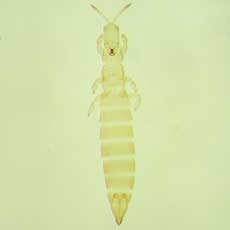
Male similar to female but smaller; sternites without glandular areas; tergite IX with 2 pairs of stout thorn-like setae.
Aptinothrips rufus (Haliday, 1836)
| Biology | |
| Breeding
on the leaves of various, but unspecified, grass species, this thrips
is sometimes abundant in pastures, but there is little evidence that
it damages grass crops. |
 |
| Distribution | |
| Found
in countries with temperate climates throughout the world, including
highland areas in tropical countries. |
|
| Recognition | |
| Female
apterous; body colour yellow, antennal segment VI shaded with brown.
Antennae 6-segmented, VI twice as long as V, III & IV each with simple
sense cone. Head, longer than wide, without ocelli or long setae. Pronotum
without long setae; meso and metanotum transverse; tarsi each with one
segment. Tergites with discal setae variable, 2 – 20; tergite IX
posteromedian pair of setae short, about 0.2 times as long as lateral
pair; tergites and sternites without craspedum; sternites with many discal
setae. Male similar to female but smaller; sternites without glandular areas; tergite IX with 2 pairs of stout thorn-like setae. |
|
| Related species | |
| Five species are listed in this genus (Palmer, 1975), all completely wingless, but differing in the number of antennal and tarsal segments, and also in details of the tergal and sternal chaetotaxy. The only related species that is encountered commonly is A. stylifer, but in that the antennae are 8-segmented and the tergites lack discal setae. | |